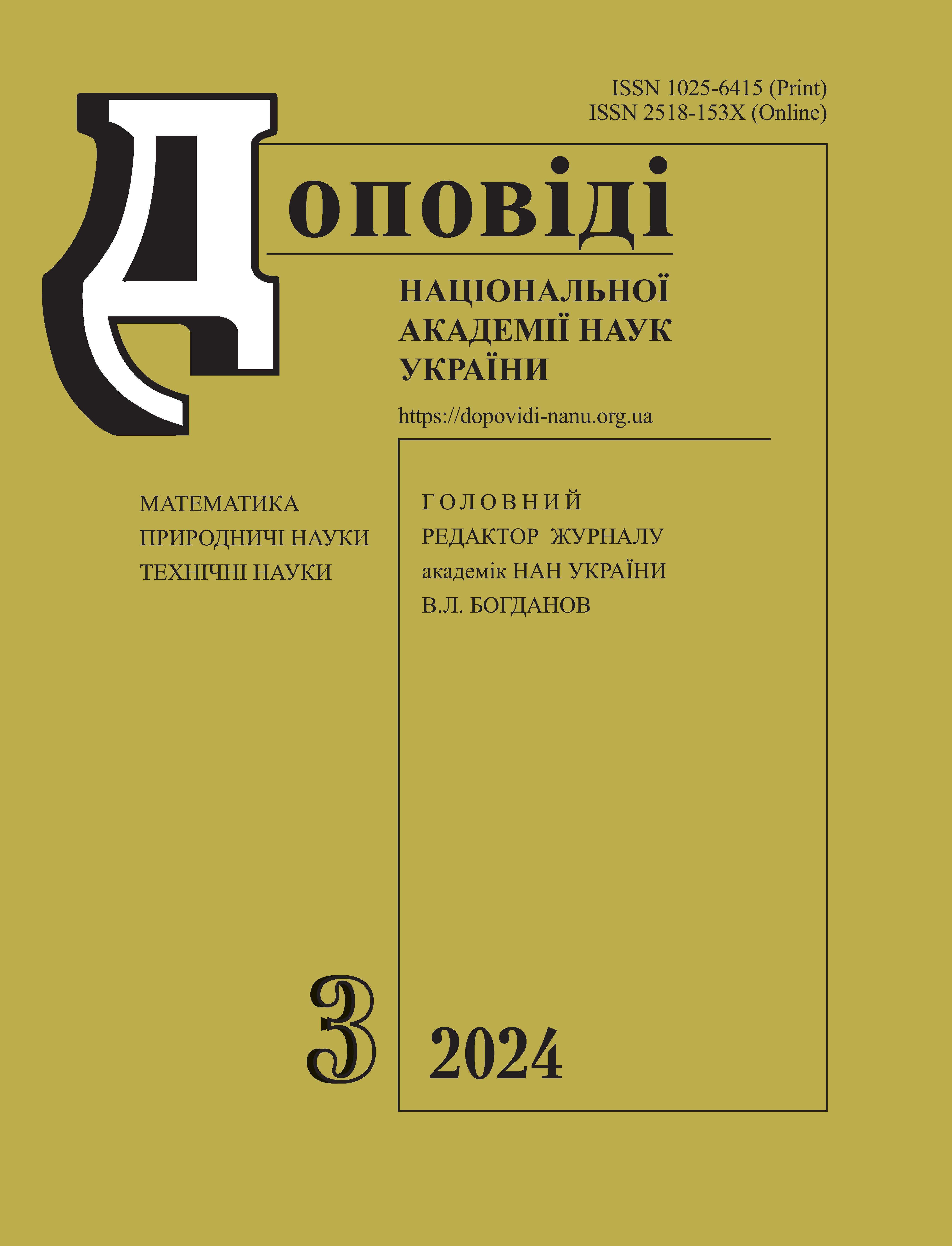PECULIARITIES OF PHYSICAL PROCESSES OF FORMATION OF SILICON SURFACE-BARRIER STRUCTURES
DOI:
https://doi.org/10.15407/dopovidi2024.03.035Keywords:
high-resistance silicon, surface-barrier structures, semiconductor detectors, spectrometry of nuclear radiationsAbstract
Semiconductor detectors occupy a prominent place among nuclear spectrometry instruments and are used to study the spectral composition, intensity, spatial and angular distributions of ionizing particles. Silicon is the most attractive material for detector production due to the advanced silicon technology and the possibility of creating not only dosimetric and radiometric, but also spectrometric detectors. Silicon-based semiconductor detectors are used to detect charged particles, as well as gamma quanta, including those with an energy of less than 100 keV and X-ray radiation. The results of a comprehensive study of the properties of the initial high-resistive n-Si with the aim of improving the technology of manufacturing silicon spectrometric semiconductor detectors with predetermined parameters were generalized. For plane-parallel etching of silicon crystals, methods of chemical treatment of the Si surface have been developed by selecting the composition of etchants based on high-purity acids. A method of accelerated formation of surface-barrier structures by applying an external electric field at the stage of their formation was proposed. Conditions for holding the structures for optimal formation of high-quality and stable surface-barrier p—n junctions were determined. On the basis of an optimized surface-barrier technology using large-diameter high-resistance n-Si, dE/dx-detectors have been developed with a working area of 8 cm2 and a range of thicknesses of the sensitive area from tens of microns to a millimetre, with thin input and output “windows” and an energy resolution no worse than 100 keV. The obtained detectors can be used in consisting of telescopes in nuclear experiments involving heavy ions at low yields of reaction products.
Downloads
References
Parker, R. P. (1970). Semiconductor nuclear radiation detectors. Phys. Med. Biol., 15, No. 4, pp. 605-620. https:// doi.org/10.1088/0031-9155/15/4/201
Sahoo, D. (2014). Al/Au/n-Si/Al Surface Barrier Detector. Proceedings of the DAE Symposium on Nuclear Physics., 59, pp. 868-869. http://www.sympnp.org/proceedings/
Sannakki, B. & Devendrappa, M. (2014). Measurement of energy loss of light ions using silicon surface barrier detector. Int. J. Res. Eng. Technol., 03, No. 03, pp. 286-289. https://doi.org/10.15623/ijret.2014.0315055
Kim, S., Park, S. H., Ha, J. H., Cho, S. Y. & Kim, Y. K. (2008). Characteristics of Silicon Surface Barrier Radiation Detectors for Alpha Particle Detection. J. Korean Phys. Soc., 52, No. 6, pp. 1754-1758. https://doi.org/10.3938/jkps.52.1754
Lutz, G. (2007). Semiconductor Radiation Detectors. Device Physics. Berlin-Heidelberg: Springer-Verlag.
Cywiak, M., Iturbe, J. L., Gallardo, R. & Bulbulian, S. (1988). Surface barrier detector device and its application to alpha spectroscopy. J. Radioanal. Nucl. Chem., 126, No. 2, pp. 145-151. https://doi.org/10.1007/BF02162433
Muggleton, A. H. F. (1972). Semiconductor devices for gamma ray, X ray and nuclear radiation detection. J. Phys. E: Sci. Instrum., 5, No 5, pp. 390-404. https://doi.org/10.1088/0022-3735/5/5/001
Von Dincklage, R.-D. & Gerl, J. (1985). The response function of a Si(Li) detector for monoenergetic electrons. Nucl. Instr. Meth. Phys. Res. A, 235, No. 1, pp. 198-199. https://doi.org/10.1016/0168-9002(85)90262-1
Zhang, Y. & Whitlow, H. J. (2002). Response of Si p-i-n diode and Au/n-Si surface barrier detector to heavy ions. Nucl. Instr. Meth. Phys. Res. B, 190, No. 1-4, pp. 383-386. https://doi.org/10.1016/S0168-583X(01)01240-X
Akimov, Yu. K., Ignat’yev, O. V., Kalinin, A. I. & Kushniruk, V. F. (1989). Semiconductor detectors in experimental physics. Moscow: Energoatomizdat (in Russian).
Sharma, R. P. (1988). Development of high resolution silicon surface barrier detectors. Pramana-J. Phys., 31, No. 3, pp. 185-195. https://doi.org/10.1007/BF02848805
Khandaker, M. U. (2011). High purity germanium detector in gamma-ray spectrometry. Int. J. Fundam. Phys. Sci., 1, No. 2, pp. 42-46. https://doi.org/10.14331/ijfps.2011.330011
England, J. B. A. & Hammer, V. W. (1971). A new type of non-injecting back contact for totally depleted silicon surface barrier detectors. Nucl. Instrum. Methods, 96, No. 1, pp. 81-83. https://doi.org/10.1016/0029- 554X(71)90440-X
Agostinelli, S., Allison, J., Amako, K., Apostolakis, J., Araujo, H., Arce, P., Asai, M., Axen, D., Banerjee, S., Barrand, G., Behner, F., Bellagamba, L., Boudreau, J., Broglia, L., Brunengo, A., Burkhardt, H., Chauvie, S., Chuma, J., Chytracek, R., Cooperman, G., Cosmo, G., Degtyarenko, P., Dell’Acqua, A., Depaola, G., Dietrich, D., Enami, R., Feliciello, A., Ferguson, C., Fesefeldt, H., Folger, G., Foppiano, F., Forti, A., Garelli, S., Giani, S., Giannitrapani, R., Gibin, D. & Gómez Cadenas, J. J. (2003). Geant4 — a simulation toolkit. Nucl. Instr. Meth. Phys. Res. A., 506, No. 3, pp. 250-303. https://doi.org/10.1016/S0168-9002(03)01368-8
Stojanovic, M., Osmokrovic, P., Boreli, F., Novković, D. & Webb, R. (1997). Characteristics of large area silicon surface barrier detectors. Thin Solid Films, 296, No. 1-2, pp. 181-183. https://doi.org/10.1016/S0040-6090(96)09334-0
Downloads
Published
How to Cite
Issue
Section
License
Copyright (c) 2024 Reports of the National Academy of Sciences of Ukraine

This work is licensed under a Creative Commons Attribution-NonCommercial 4.0 International License.




